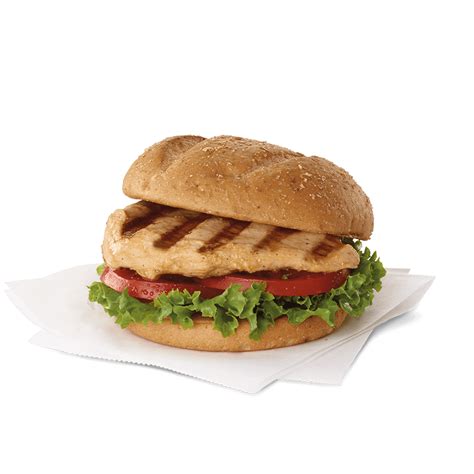
Chick-fil-A’s grilled chicken offerings, often perceived as a healthier alternative to fried options, may not be as nutritionally sound as many consumers believe, according to recent analysis. While lower in calories and fat compared to their fried counterparts, these items can be surprisingly high in sodium and may contain hidden ingredients that detract from their overall healthfulness.
Chick-fil-A’s Grilled Chicken: Unpacking the Nutritional Profile
Chick-fil-A has long been a popular fast-food destination, recognized for its customer service and iconic chicken sandwich. As health consciousness grows, many patrons are opting for grilled chicken items, assuming they are making a more nutritious choice. However, a closer examination of the nutritional information reveals a more complex picture.
One of the primary concerns highlighted by nutrition experts is the sodium content in Chick-fil-A’s grilled chicken. “While grilled chicken is certainly lower in calories and fat compared to fried options, consumers need to be mindful of the sodium content, which can be surprisingly high,” explains a registered dietitian.
Sodium Levels: A Cause for Concern
High sodium intake is linked to several health issues, including hypertension, heart disease, and stroke. The American Heart Association recommends consuming no more than 2,300 milligrams of sodium per day, with an ideal limit of 1,500 milligrams for most adults. Many of Chick-fil-A’s grilled chicken items can contribute a significant portion of this daily allowance in just one meal.
For example, the Grilled Chicken Sandwich contains a considerable amount of sodium. While the exact figures can vary slightly depending on preparation and specific ingredients, it often approaches or exceeds half of the recommended daily sodium intake for many individuals. This is particularly concerning for those who frequently dine at Chick-fil-A or consume other high-sodium foods throughout the day.
The high sodium content is not always immediately apparent to consumers. Unlike calories or fat, sodium levels are less prominently displayed and often overlooked. Furthermore, the perception that grilled chicken is inherently healthy can lead individuals to underestimate the sodium content.
Hidden Ingredients and Additives
Beyond sodium, another area of concern is the presence of various additives and processed ingredients in Chick-fil-A’s grilled chicken. These ingredients are often used to enhance flavor, preserve freshness, or improve texture. However, some of these additives may have potential health implications.
“Many fast-food items, including grilled chicken, contain additives and preservatives that are not ideal for optimal health,” notes another nutritionist. “Consumers should be aware of these ingredients and make informed choices based on their individual dietary needs and preferences.”
Common additives found in Chick-fil-A’s grilled chicken include modified food starch, monosodium glutamate (MSG), and various artificial flavors and preservatives. While these ingredients are generally recognized as safe by regulatory agencies like the FDA, some individuals may experience adverse reactions or sensitivities.
For instance, MSG has been linked to headaches, nausea, and other symptoms in sensitive individuals. Similarly, artificial flavors and preservatives may trigger allergic reactions or exacerbate existing health conditions.
Moreover, the use of processed ingredients can detract from the overall nutritional value of the grilled chicken. Whole, unprocessed foods are generally more nutrient-dense and offer a wider range of health benefits. By comparison, processed ingredients often lack essential vitamins, minerals, and antioxidants.
Comparing Grilled Chicken Options
To provide a clearer perspective, it is helpful to compare Chick-fil-A’s grilled chicken offerings with other fast-food restaurants. While nutritional information varies across different establishments, some general trends emerge.
In many cases, Chick-fil-A’s grilled chicken items tend to be comparable to or slightly higher in sodium than similar offerings from competitors. This is partly due to the specific recipes and preparation methods used by Chick-fil-A.
For example, the marinating process used to flavor the grilled chicken often involves sodium-rich ingredients. Additionally, the sauces and toppings added to the sandwiches and salads can further contribute to the overall sodium content.
However, it is important to note that Chick-fil-A has made efforts to improve the nutritional profile of its menu items in recent years. The company has removed certain artificial ingredients and reduced sodium levels in some products.
Despite these efforts, consumers should still exercise caution and carefully review the nutritional information before making their selections. Paying attention to sodium levels and ingredient lists can help individuals make more informed and healthier choices.
The Grilled Chicken Sandwich: A Closer Look
The Grilled Chicken Sandwich is one of Chick-fil-A’s most popular grilled chicken items. While it is lower in calories and fat than the classic Chick-fil-A Chicken Sandwich, it still presents some nutritional concerns.
A typical Grilled Chicken Sandwich contains approximately 380 calories, 14 grams of fat, and 37 grams of protein. However, it also contains a significant amount of sodium, often exceeding 700 milligrams.
The sodium content is largely attributed to the marinated chicken breast, the bun, and the various toppings and sauces. For example, the multigrain bun, while a healthier alternative to a white bun, can still contribute a notable amount of sodium.
Additionally, the honey-roasted BBQ sauce, which is a popular accompaniment to the Grilled Chicken Sandwich, is high in sugar and sodium. Opting for a different sauce or omitting it altogether can help reduce the overall sodium content.
To make a healthier choice, consumers can consider customizing their Grilled Chicken Sandwich. Some strategies include:
- Ordering the sandwich without sauce or choosing a low-sodium alternative.
- Removing the bun and eating the chicken breast as a lettuce wrap.
- Adding fresh vegetables, such as lettuce, tomato, and onions, for added nutrients.
- Pairing the sandwich with a side salad instead of fries or other high-calorie sides.
Grilled Nuggets and Other Options
In addition to the Grilled Chicken Sandwich, Chick-fil-A offers other grilled chicken options, such as Grilled Nuggets and Grilled Chicken Cool Wrap. These items also have their own unique nutritional profiles.
Grilled Nuggets are a popular choice for children and adults alike. They are lower in calories and fat than the traditional Chick-fil-A Nuggets, but they still contain a notable amount of sodium.
A typical serving of 8 Grilled Nuggets contains approximately 130 calories, 3 grams of fat, and 25 grams of protein. However, it also contains around 390 milligrams of sodium.
The sodium content is primarily attributed to the marinating process and the seasonings used to flavor the nuggets. As with the Grilled Chicken Sandwich, consumers can reduce their sodium intake by ordering the nuggets without sauce or choosing a low-sodium alternative.
The Grilled Chicken Cool Wrap is another option that is often perceived as a healthier choice. It consists of grilled chicken, lettuce, cheese, and other vegetables wrapped in a flaxseed flour flatbread.
While the Grilled Chicken Cool Wrap offers a good source of protein and fiber, it also contains a significant amount of sodium. A typical wrap contains approximately 340 calories, 13 grams of fat, and 29 grams of protein, along with around 1080 milligrams of sodium.
The high sodium content is due to the marinated chicken, the cheese, and the dressing. Consumers can reduce their sodium intake by asking for the dressing on the side or choosing a low-sodium alternative. They can also opt for a light cheese or ask for no cheese.
Making Informed Choices
Ultimately, the key to making healthy choices at Chick-fil-A, or any fast-food restaurant, is to be informed and mindful of the nutritional content of the menu items. Consumers should take the time to review the nutritional information and ingredient lists before placing their orders.
Chick-fil-A provides detailed nutritional information on its website and in its mobile app. This information includes calorie counts, fat content, sodium levels, and ingredient lists for all of its menu items.
By reviewing this information, consumers can make more informed choices and tailor their orders to meet their individual dietary needs and preferences. They can also use online tools and resources to track their calorie and sodium intake and ensure that they are staying within healthy limits.
“It’s all about balance and moderation,” advises a registered dietitian. “Enjoying Chick-fil-A occasionally as part of a balanced diet is perfectly fine. Just be mindful of portion sizes and choose lower-sodium options whenever possible.”
The Role of Preparation Methods
The preparation methods used by Chick-fil-A can also impact the nutritional content of its grilled chicken items. For example, the marinating process, while adding flavor and tenderness, can also increase the sodium content.
The chicken is typically marinated in a brine solution that contains salt and other seasonings. This process allows the flavors to penetrate the chicken, resulting in a more flavorful and juicy product. However, it also means that the chicken absorbs a significant amount of sodium.
The cooking method used to grill the chicken can also affect its nutritional content. Grilling is generally considered a healthier cooking method than frying because it does not require the addition of oil or fat.
However, grilling can also lead to the formation of potentially harmful compounds, such as heterocyclic amines (HCAs) and polycyclic aromatic hydrocarbons (PAHs). These compounds are formed when meat is cooked at high temperatures, and they have been linked to an increased risk of cancer.
To minimize the formation of HCAs and PAHs, Chick-fil-A uses specific grilling techniques and equipment. These techniques include cooking the chicken at lower temperatures and avoiding direct contact with the flames.
Despite these efforts, it is still important to be aware of the potential risks associated with grilling and to consume grilled chicken in moderation as part of a balanced diet.
The Impact of Sides and Beverages
In addition to the grilled chicken itself, the sides and beverages that accompany it can also have a significant impact on the overall nutritional value of the meal. Many of Chick-fil-A’s side items are high in calories, fat, and sodium.
For example, the Waffle Fries, one of Chick-fil-A’s most popular side items, are high in calories and fat. A medium order of Waffle Fries contains approximately 420 calories, 24 grams of fat, and 270 milligrams of sodium.
Similarly, the Mac & Cheese is also high in calories and fat. A small order of Mac & Cheese contains approximately 270 calories, 17 grams of fat, and 680 milligrams of sodium.
To make healthier choices, consumers can opt for lower-calorie and lower-sodium side items, such as the Kale Crunch Side or the Side Salad. These options provide essential vitamins, minerals, and fiber without adding excessive calories, fat, or sodium.
Beverages can also contribute significantly to the overall calorie and sugar content of a meal. Many of Chick-fil-A’s beverages, such as lemonade and sweet tea, are high in sugar.
To make healthier choices, consumers can opt for sugar-free or low-sugar beverages, such as water, unsweetened tea, or diet soda. They can also ask for their beverages to be made with less sugar or without sugar altogether.
Long-Term Health Implications
The long-term health implications of consuming Chick-fil-A’s grilled chicken, or any fast-food item, depend on the frequency and quantity of consumption, as well as the overall dietary habits of the individual.
Consuming grilled chicken occasionally as part of a balanced diet is unlikely to have significant negative health consequences. However, frequent consumption of high-sodium, processed foods can increase the risk of various health problems, such as hypertension, heart disease, stroke, and type 2 diabetes.
It is important to maintain a balanced diet that includes a variety of whole, unprocessed foods, such as fruits, vegetables, whole grains, and lean protein sources. Limiting the intake of high-sodium, processed foods can help reduce the risk of these health problems.
Additionally, regular physical activity is essential for maintaining good health and reducing the risk of chronic diseases. Aim for at least 150 minutes of moderate-intensity aerobic activity or 75 minutes of vigorous-intensity aerobic activity per week.
Conclusion: A Nuanced Perspective
In conclusion, while Chick-fil-A’s grilled chicken offerings are generally lower in calories and fat than their fried counterparts, they are not necessarily a “healthy” choice without careful consideration. The high sodium content and the presence of processed ingredients can detract from their overall nutritional value.
Consumers should be aware of these factors and make informed choices based on their individual dietary needs and preferences. By reviewing the nutritional information, customizing their orders, and opting for healthier sides and beverages, individuals can enjoy Chick-fil-A occasionally as part of a balanced diet.
It is important to remember that no single food item is inherently “good” or “bad.” The overall impact of a food on health depends on the context of the entire diet and lifestyle. By adopting a balanced and mindful approach to eating, individuals can make sustainable and healthy choices that support their long-term well-being.
Frequently Asked Questions (FAQs)
-
Is Chick-fil-A’s grilled chicken actually healthy?
While lower in calories and fat compared to fried options, Chick-fil-A’s grilled chicken can be high in sodium and contain processed ingredients. It’s a better choice than fried, but not necessarily a “healthy” choice without careful consideration of the overall meal and individual dietary needs. As stated in the original article: “While grilled chicken is certainly lower in calories and fat compared to fried options, consumers need to be mindful of the sodium content, which can be surprisingly high.”
-
How much sodium is in Chick-fil-A’s Grilled Chicken Sandwich?
The sodium content in Chick-fil-A’s Grilled Chicken Sandwich can be significant, often exceeding 700 milligrams per sandwich. The exact amount may vary based on specific ingredients and preparation methods. It’s important to check the nutritional information on Chick-fil-A’s website or app for the most accurate figures.
-
What are some ways to make Chick-fil-A’s grilled chicken options healthier?
To make healthier choices, consider customizing your order. Order without sauce or choose low-sodium alternatives. Remove the bun or opt for a lettuce wrap. Add fresh vegetables like lettuce, tomato, and onions. Choose healthier sides like the Kale Crunch Side or a Side Salad. Opt for sugar-free or low-sugar beverages like water or unsweetened tea.
-
Are the Grilled Nuggets at Chick-fil-A a healthy option for kids?
Grilled Nuggets are a lower-calorie and lower-fat alternative to traditional Chick-fil-A Nuggets. However, they still contain a notable amount of sodium (around 390 milligrams per 8-piece serving). Parents should be mindful of portion sizes and consider ordering them without sauce or with a low-sodium sauce to reduce sodium intake.
-
What are the long-term health implications of frequently eating Chick-fil-A’s grilled chicken?
Frequent consumption of high-sodium, processed foods, including Chick-fil-A’s grilled chicken, can increase the risk of health problems like hypertension, heart disease, stroke, and type 2 diabetes. It’s important to maintain a balanced diet with a variety of whole, unprocessed foods and limit the intake of high-sodium, processed options. Regular physical activity is also crucial for long-term health.
Expanded Analysis
To further contextualize the nutritional information and provide a more comprehensive understanding of Chick-fil-A’s grilled chicken, a deeper dive into specific aspects is necessary. This includes examining the sodium sources in greater detail, exploring alternative options within the Chick-fil-A menu, and comparing Chick-fil-A’s offerings to other fast-food chains.
-
Delving Deeper into Sodium Sources:
The high sodium content in Chick-fil-A’s grilled chicken is not solely attributable to one ingredient. Instead, it’s a culmination of several factors, including the marinating process, the bun, the sauces, and even the cheese used in some items.
- The Marinating Process: The marinating process, essential for infusing flavor and tenderness into the chicken, typically involves a brine solution rich in salt. While enhancing the taste and texture, this process significantly increases the sodium levels in the chicken.
- The Bun: Even the bun contributes to the overall sodium content. Although Chick-fil-A offers a multigrain bun as a healthier option, it still contains a considerable amount of sodium. The sodium content in bread products is often a result of the leavening process and added preservatives.
- Sauces and Dressings: Sauces and dressings are notorious for being high in sodium. Popular choices like the honey-roasted BBQ sauce or various salad dressings can add hundreds of milligrams of sodium to a meal.
- Cheese: The inclusion of cheese in wraps or sandwiches also adds to the sodium count. Processed cheeses, commonly used in fast food, are particularly high in sodium.
-
Exploring Alternative Menu Options at Chick-fil-A:
While grilled chicken items may not be the unequivocally “healthy” choice, Chick-fil-A does offer other options that can be incorporated into a balanced diet.
- Salads: Chick-fil-A offers a variety of salads with different toppings and dressings. Choosing a salad with grilled chicken (while still mindful of sodium) and a light vinaigrette can be a relatively healthy option.
- Sides: As mentioned earlier, the Kale Crunch Side is a good source of fiber and nutrients with fewer calories and less sodium than other sides like waffle fries.
- Breakfast Options: Some of Chick-fil-A’s breakfast items, such as the Greek Yogurt Parfait or the Egg White Grill, can be healthier choices compared to other fast-food breakfast options, provided they are consumed in moderation and with attention to added sugars and sodium.
-
Comparative Analysis with Other Fast-Food Chains:
To provide a broader context, comparing Chick-fil-A’s grilled chicken offerings to similar items from other fast-food chains is essential. While direct comparisons are difficult due to variations in recipes and serving sizes, some general observations can be made.
- McDonald’s: McDonald’s offers grilled chicken sandwiches and salads. Comparing the sodium content of a similar grilled chicken sandwich reveals that McDonald’s offering might have a slightly lower sodium content than Chick-fil-A’s, but this can vary based on toppings and sauces.
- Burger King: Burger King also has grilled chicken options. Again, a direct comparison shows that Burger King’s grilled chicken sandwich can have comparable or slightly lower sodium levels, but again, this is dependent on the specific ingredients and preparation.
- Subway: Subway allows for more customization. Opting for grilled chicken on whole-wheat bread with plenty of vegetables and a light vinaigrette can be a healthier alternative compared to pre-made sandwiches.
This comparison underscores the importance of carefully reviewing the nutritional information for each item, regardless of the fast-food chain. No single restaurant automatically provides a “healthy” option without conscious choices.
-
The Psychological Impact of “Health Halo”:
The term “health halo” refers to the tendency to overestimate the healthfulness of an item based on a single attribute, such as being “grilled” or “low-fat.” This can lead consumers to make less informed choices and potentially overeat, negating any potential health benefits.
The “health halo” effect can be particularly relevant when it comes to Chick-fil-A’s grilled chicken. The perception that it’s a healthier choice can lead individuals to underestimate the sodium content and potentially consume larger portions or pair it with unhealthy sides, effectively negating any benefits.
-
The Importance of Portion Control and Mindful Eating:
Even if a menu item is relatively healthy, portion control is crucial. Consuming large portions of even healthy foods can lead to weight gain and other health problems. Mindful eating, which involves paying attention to hunger cues and savoring each bite, can help prevent overeating and promote a healthier relationship with food.
-
Future Directions for Chick-fil-A and the Fast-Food Industry:
As consumer demand for healthier options continues to grow, Chick-fil-A and other fast-food chains are likely to continue innovating and offering more nutritious menu items. This could include reducing sodium content, using more whole, unprocessed ingredients, and providing clearer nutritional information.
However, it’s ultimately up to consumers to make informed choices and prioritize their health. By being aware of the nutritional content of fast-food items and adopting a balanced and mindful approach to eating, individuals can enjoy these foods occasionally without compromising their well-being.









